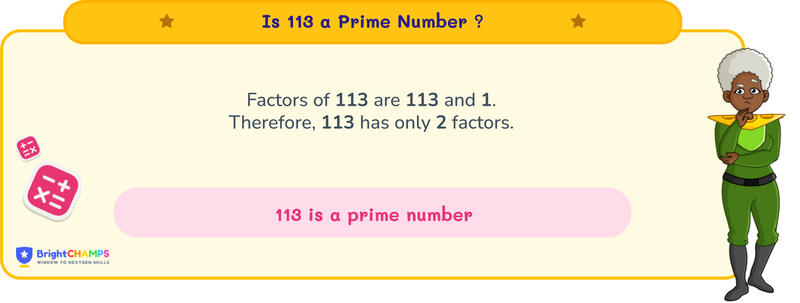Summarize this article:
 143 Learners
143 LearnersLast updated on 5 August 2025
Is 113 a Prime Number?

The numbers that have only two factors, which are 1 and itself, are called prime numbers. Prime numbers are crucial in various fields such as encryption, computer algorithms, and barcode generation. In this topic, we will be discussing whether 113 is a prime number or not.

Is 113 a Prime Number?
There are two types of numbers, mostly
- Prime numbers
- composite numbers
depending on the number of factors. A prime number is a natural number that is divisible only by 1 and itself. For example, 3 is a prime number because it is divisible by 1 and itself. A composite number is a positive number that is divisible by more than two numbers. For example, 6 is divisible by 1, 2, 3, and 6, making it a composite number.
Prime numbers follow a few properties: - Prime numbers are positive numbers always greater than 1. - 2 is the only even prime number. - They have only two factors: 1 and the number itself. - Any two distinct prime numbers are co-prime numbers because they have only one common factor, which is 1. Since 113 has only two factors, it is a prime number.


Why is 113 a Prime Number?
The characteristic of a prime number is that it has only two divisors: 1 and itself. Since 113 has exactly two factors, it is a prime number. A few methods are used to distinguish between prime and composite numbers:
- Counting Divisors Method
- Divisibility Test
- Prime Number Chart
- Prime Factorization

Using the Counting Divisors Method
The method in which we count the number of divisors to categorize the numbers as prime or composite is called the counting divisors method. Based on the count of the divisors, we categorize numbers as prime and composite.
- If there is a total count of only 2 divisors, then the number is prime.
- If the count is more than 2, then the number is composite.
Let’s check whether 113 is prime or composite.
Step 1: All numbers are divisible by 1 and themselves.
Step 2: Check divisibility by numbers up to the square root of 113, which is approximately 10.63.
Step 3: 113 is not divisible by any numbers other than 1 and 113 itself. Since 113 has only 2 divisors, it is a prime number.

Using the Divisibility Test Method
We use a set of rules to check whether a number is divisible by another number completely or not. It is called the Divisibility Test Method.
Divisibility by 2: 113 is not divisible by 2 since it is odd.
Divisibility by 3: The sum of the digits in 113 is 5, which is not divisible by 3.
Divisibility by 5: The unit’s place digit is 3, so it is not divisible by 5.
Divisibility by 7: Double the last digit (3 × 2 = 6). Subtract from the rest of the number (11 - 6 = 5). 5 is not divisible by 7.
Divisibility by 11: The difference between the sum of the digits in odd positions (1 + 3) and even positions (1) is 3, which is not divisible by 11. Since 113 is not divisible by any number other than 1 and 113 itself, it is a prime number.

Using Prime Number Chart
The prime number chart is a tool created by using a method called “The Sieve of Eratosthenes.” In this method, we follow the following steps:
Step 1: Write numbers from 1 to 120 in rows and columns.
Step 2: Leave 1 without coloring or crossing, as it is neither prime nor composite.
Step 3: Mark 2 because it is a prime number and cross out all the multiples of 2.
Step 4: Mark 3 because it is a prime number and cross out all the multiples of 3.
Step 5: Repeat this process for numbers up to around the square root of the highest number in the chart. Through this process, we will have a list of prime numbers. Since 113 appears in the list of prime numbers, it is verified as a prime number.

Using the Prime Factorization Method
Prime factorization is a process of breaking down a number into prime factors. Then multiply those factors to obtain the original number. Since 113 is a prime number, it cannot be broken down further into other prime factors. Therefore, the prime factorization of 113 is just 113 itself.

Important Glossaries for "Is 113 a Prime Number"
- Prime Numbers: Natural numbers greater than 1 that have no divisors other than 1 and itself.
- Composite Numbers: Natural numbers greater than 1 that have more than two distinct divisors.
- Divisibility Test: A method used to determine if one number is divisible by another without performing division.
- Sieve of Eratosthenes: An ancient algorithm used to find all primes up to a specified integer.
- Co-Prime Numbers: Two numbers that have only 1 as their common divisor.

Explore More numbers
![Important Math Links Icon]() Previous to Is 113 a Prime Number?
Previous to Is 113 a Prime Number?
![Important Math Links Icon]() Next to Is 113 a Prime Number?
Next to Is 113 a Prime Number?

About BrightChamps in United Arab Emirates


Hiralee Lalitkumar Makwana
About the Author
Hiralee Lalitkumar Makwana has almost two years of teaching experience. She is a number ninja as she loves numbers. Her interest in numbers can be seen in the way she cracks math puzzles and hidden patterns.
Fun Fact
: She loves to read number jokes and games.




